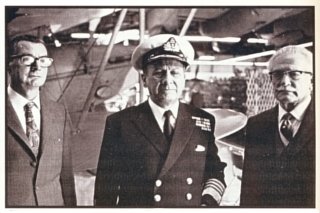

 The South African
The South African
Hugo Biermann was born in Johannesburg and educated at Jan van Riebeeck High School. A visit to a Union-Castle passenger liner in Cape Town at an early age convinced him that his future lay with the sea. In 1932 he joined the Merchant Navy training ship General Botha in Simon's Bay where he served a two-year cadetship and acquired a Master's Certificate of Competency in the British Merchant Navy.
At the outbreak of the Second World War (1939-1945), Biermann was commissioned in the South African Naval Forces and commanded a number of South African little ships, both at home and in the Mediterranean. His most famous command was the salvage vessel HMSAS Gamtoos, which took responsibility for clearing several Mediterranean ports of sunken and scuttled ships. The crew included seventeen non-Europeans, the first black South African naval personnel to be sent to an active war zone. Lt-Cdr Biermann was appointed an Officer of the Military Division of the Order of the British Empire (OBE) 'for distinguished service during the invasion of Southern France'.
After the Second World War, Biermann was appointed Officer Commanding the Algerine Class ocean minesweeper, HMSAS Bloemfontein. In 1952 he attended the Royal Navy Staff College at Greenwich and remained in London as South African Defence Attache after being promoted to commander.
With the National Party in power and the Minister of Defence, Frans Erasmus, having made it his top priority to create a 'national' Defence Force through officer purges and redeployment, Biermann's rise in rank to commodore and his appointment in 1952 as Naval and Marine Chief of Staff, at the relatively young age of 36, was initially viewed with scepticism in some quarters. However, the fully bilingual Biermann, in command of the Navy, never allowed politics to interfere with his work and soon earned a reputation as a friendly, open and approachable man of strong character who put the Navy, its standards and traditions, first. He played a significant role in the negotiations which culminated in the Simon's Town Agreement of 1957, which saw a considerable growth in the Navy in the 1960s, culminating with the addition of a submarine branch towards the end of the decade.
In 1972 Biermann reached the high point of his military career when he became Chief of the South African Defence Force. This promotion was widely seen as a sign of the beginnings of a more tolerant society in South Africa. Biermann's tenure as Chief of the SADF coincided with a turbulent period of political change in southern Africa. South African forces made deep incursions into Angola in 1975 while the Border War against SWAPO on the Namibian/Angolan Border intensified. As the conflict in Angola dragged on, Biermann resisted attempts to extend the war further and was influential in the decision to withdraw all troops from Angola in early 1976. The withdrawal from Angola coincided with his retirement from the SADF in August 1976.

Biermann is remembered for the manner in which he associated with all ranks in the South African Defence Force, no matter their branch of service. He also received praise for his tactful handling of the political situation in which he had to serve. Roger Williams wrote that Biermann never revealed his political affiliations in public and was taught from childhood to respect all South Africans, regardless of race, colour or creed. As an example of this, in 1966 he declared it his intention to allow black South Africans to serve in the Navy and also fought against government attempts to remove Cape Malay traders from Simon's Town.
For many years, Admiral Biermann served on the Board of the South African National War Museum (now Ditsong: National Museum of Military History) as the representative of the South African Navy, but his association with the Museum extended long beyond his service on the Board. In 1972, as Chief of the South African Defence Force, Admiral Biermann brought the Defence High Command to the Museum.
Allan Sinclair
Return to Journal Index OR Society's
Home page
Ditsong National Museum of Military History